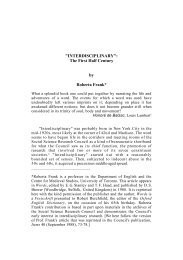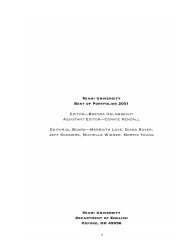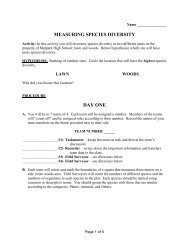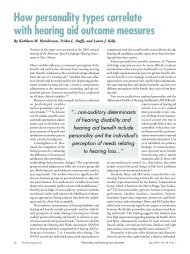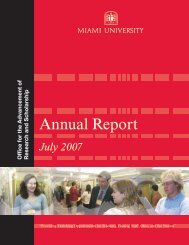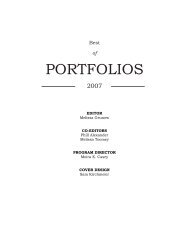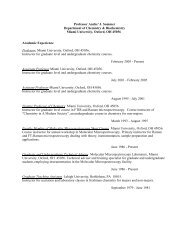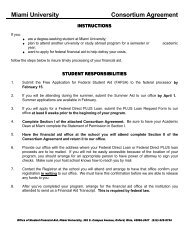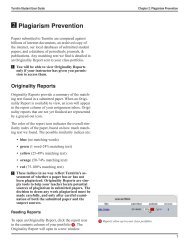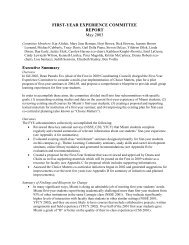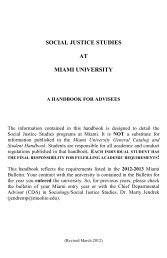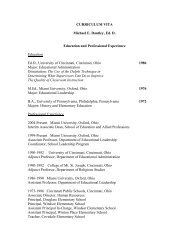Interdisciplinary Research Manual - Units.muohio.edu
Interdisciplinary Research Manual - Units.muohio.edu
Interdisciplinary Research Manual - Units.muohio.edu
You also want an ePaper? Increase the reach of your titles
YUMPU automatically turns print PDFs into web optimized ePapers that Google loves.
55<br />
terms can normally be limited to one sentence and defined in the text immediately after<br />
you use them the first time, even if you include them in a glossary as well.<br />
Appendix, Appendices. If you include an appendix (or several appendices), it<br />
should be on the last pages before the back cover. An appendix might include original<br />
data you collected, transcripts of interviews you conducted, email correspondence with<br />
an expert in the field, short hard-to-find documents (e.g., found in unpublished archives<br />
or out-of-print books), photographs you took of your subject, etc. If you make explicit<br />
use of this material in the body of the project, then you should include it as a table, figure,<br />
or illustration in the body of the project (as close as possible to immediately after your<br />
first mention of it in the text). If it is too long (i.e., it would disrupt the flow of the<br />
chapter), then consider putting the full document in the appendix and an excerpt, figure,<br />
diagram, etc. based on it in the chapter.<br />
Mechanics<br />
Common Punctuation Errors. When in doubt, do not use a comma; you need a<br />
reason to use a comma. For example, do not use a comma before a phrase; e.g., no<br />
comma before “and” in “The job exposed me to the inner workings of running a business<br />
and providing customer service.”<br />
Don’t use a comma before the second half of a compound sentence; e.g., no<br />
comma before “and” in “We are all consumers and have all had customer service<br />
experience.”<br />
Use a comma to separate short complete sentences connected by a conjunction;<br />
e.g., “We are all consumers of goods, and we have all had service experience.”<br />
Use a semi-colon to separate two complete sentences that are longer or when the<br />
connection between them is anything other than a conjunction; e.g., “We are all<br />
consumers in this world; however, some of us have had more shopping experience than<br />
others.”<br />
Use commas to set off a phrase that interrupts the flow of the sentence; e.g.,<br />
“Community members are more than registered users because, instead of just<br />
contributing information, they also interact with other users.”<br />
No need for an apostrophe in dates; e.g., 1960s not 1960’s.<br />
Periods and commas go inside the quotation marks, while colons and semi-colons<br />
go outside the quotation marks. In-text citations are part of the sentence but usually not<br />
part of the quotation, so they go inside the period but outside the quotation marks, as in<br />
“The readings based on Foucault are sensitive to the political impacts of Buddhism”<br />
(Greene 2005).<br />
Quotes within quotes go in single quotation marks; e.g., Horrocks suggests that<br />
“all writers are engaged in ‘sub-creation’ to the extent that…”<br />
E.g., i.e., et al., and etc. are all (with the exception of “et” in “et al.”)<br />
abbreviations of Latin words so they need periods: “e.g.,” indicates that an example<br />
follows; “i.e.,” indicates that a clarification or explanation follows; and “et al.” indicates<br />
that there was more than one co-author; and you know what “etc.” indicates.<br />
It’s is an abbreviation for “it is”; its is possessive; and there is no such thing as its’<br />
The apostrophe goes after the “s” in the plural form of a noun; e.g., “peasants’<br />
revolt.” When a name ends in “s,” the possessive adds “’s”; e.g., “Chris’s.”



